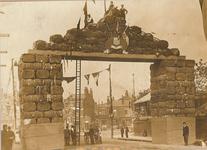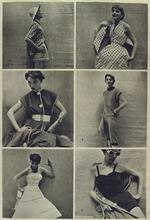Business records of Horrockses, Crewdson and Co, predecessor companies and subsidiaries; including financial records, deeds, minutes, correspondence, reports, wages books, pattern books, sample books, manufacturing records, photographs and publicity material.
Horrockses, Crewdson and Co, cotton manufacturers, Preston, Lancashire
This material is held atLancashire Archives
- Reference
- GB 55 DDHS
- Dates of Creation
- 1712-1962
- Name of Creator
- Language of Material
- English
- Physical Description
- 304 boxes
- Digital Content
Scope and Content
Administrative / Biographical History
The company was formed by John Horrocks in 1791. John Horrocks was the son of Mr John Horrocks, a quarry master and manufacturer of millstones at Edgworth near Bolton. At the time, the cotton business and the textile industry was expanding and John Horrocks was interested in the business possibilities. He originally bought two or three frames to spin cotton and started his business in his father’s factory. The yarn produced was sold to a Mr John Watson, who occupied the first cotton mill within Preston. After a disagreement with Watson and realising the potential of the textile industry, John Horrocks set up his own business in Preston.
Initially, the business started in a small building within Turk’s Head Court, Preston. With his business growing, John Horrocks realised that he needed more capital to develop and began to search for a business partner. One potential business partner, a Mr Bolton, was apparently scared away by Horrocks' enthusiasm, but a successful partnership with a Mr Richard Newsham allowed Horrocks to build his first mill in 1791 on Dale Street, Preston. After the first mill was built, the business continued to grow with a series of mills built over the course of ten years.
As the business began to develop, John asked his brother Samuel to join him and made him a partner within the firm. John also invited his uncle, Issac Horrocks, to join the business and later gave him the Turks Head Court business. As the business grew, John Horrocks' position in Preston also grew. Horrocks was a parliamentary candidate for the borough in 1796 but did not win a position until 1802. John Horrocks also built Penwortham Hall, which at the time was called Penwortham Lodge. John Horrocks built a very successful business and prospered within society. Known to be a kind and generous man, he died in London in 1804 at the age of 36.
John Horrocks was succeeded both in his business and as the parliamentary representative for Preston by his brother Samuel. While John Horrocks did have children, none of them seem to take any role in the business. Archive sources reveal that John Horrocks left his partnership in the business to his son John Horrocks while leaving the bulk of his money to his son Peter Horrocks. Records reveal that John sold his shares in the firm to his uncle when he came of age in 1815. There are also records that Peter Horrocks sold Penwortham Lodge in 1829. All further references to Horrocks within the company refer to Samuel Horrocks.
By 1815, the company was called Horrocks, Miller and Co. Thomas Miller began to work for Horrocks brothers in 1802 specialising in clouding. Clouding was a term used to describe a different type of yarn. The yarn was "developed by twist and colour, [and] is achieved by running two yarns of strongly contrasted colours through separate pairs of rollers". Thomas Miller was originally from Bolton, but was recommended to John and Samuel Horrocks and they made him a partner of the firm. Miller was also influential within the borough of Preston becoming a council member like John and Samuel Horrocks. After his death in January 1840, he left a large interest and the principal management of Horrocks, Miller and Co. to his son Thomas Miller.
By 1840, following the death of Samuel Horrocks and his son, there are no references or records of any involvement of the Horrocks family within the business. After the death and retirement of many members, Thomas Miller became the sole proprietor of Horrocks, Miller and Co. Miller was a popular figure within the community having purchased the estate and manor of Singleton in Fylde and became one of the largest landowners in Fylde. He was known to be a very generous man and donated to many causes including the rebuild of his local church. Similar to partners before him, he was also involved in the local councils. Thomas Miller married Henrietta Sarah, a daughter of Rev. Cornelius Pitt in 1841 who was also the niece of John and Samuel Horrocks. They had five children but like previous children of partners, none of them seem to have any involvement within the textile business and it was known that upon his death in 1865, his eldest son was preparing to enter the army.
Once Thomas Miller took over the control of the firm in 1840, other people who were involved in the firm became partners within the business. In 1860, a Mr Edward Hermon, who previously had been a salesman, was admitted a partner and in 1866, a Mr Styles, who was the London salesman, was admitted. Thomas Miller died in 1865 and by 1887; Horrockses, Crewdson & Co was firmly established.
Talks between Horrocks, Miller and Co. and Crewdson, Crosses and Co. Ltd took place in 1885 but it wasn't until 1887 that the two companies merged to become Horrockses, Crewdson & Co. The company planned to remain "businesses of Cotton Spinners, Doublers and manufacturers of Cloth and other goods manufactured from cotton". By merging the companies, there were more partners involved and more business connections. The creation of Horrockses, Crewdson & Co. was the start of a new period for the company. Offices were based in Preston, Manchester and London and the company was expanding further with more possibilities overseas.
The company grew and prospered with more subsidiary companies and an increase in the amount of cotton and products produced. Throughout this period, the board of directors changed frequently due to death and retirement. With the company expanding and documents often lacking in details, it is hard to keep a record of all the directors of the company. The lack of documents within the Horrockses, Crewdson & Co. collection at Lancashire Archives often produces gaps in the history of the company. Gaps in the history of the company continue to grow as very little is known about what happens to the company during the First and Second World Wars. While there is little information about the company during the First World War, information can be found in reference to the Second World War.
During the Second World War, the company was involved in the "Government's concentration scheme". The scheme was a "voluntary merger of factories in order to free up space and production facilities for essential war work". Records suggest that Horrockses, Crewdson & Co. were involved in producing the materials needed for the warfront. While there are limited accounts about what Horrockses, Crewdson & Co. produced during the war, there are records of war time accounts, insurances and other war time plans such as air raid precaution plans for the mills. Documents reveal the various air raid precautions that took place at the Moses Gate Mill. Precautions included every member of staff knowing the nearest fire exit, who was their A.R.P. warden and where the nearest shelters were. The precautions were taken very seriously with at least one drill every month starting from 1938. There are also records of the war casualties from all Horrockses, Crewdson & Co. businesses and factories. The records of each individual mill or business show the name and rank of the men who died. Overall, at least 139 men from across the company died.
Following the war, the economy had changed and the way people bought clothes and fabrics had also changed. "Ready-to-wear manufacture had been growing steadily during the period between the two World Wars" and Horrockses, Crewdson & Co." saw the opportunities for the business. In 1946, the first collection from Horrockses Fashions became available in retailers. Horrockses Fashions had the advantage of the Horrocks name which had a strong reputation with the fabric industry. Additionally, "Horrockses Fashion collections were predominantly made from cotton cloth that had been woven at the Preston factory, with fabrics designed exclusively for them". Horrockses Fashions was a huge success for the company. The popularity of the clothing expanded and Horrockses Fashions was producing many clothing items from "simple cotton shirtwaisters made from colourful floral prints" to "glamorous evening gowns". Horrockses Fashions was soon that popular and well respected that "The Queen packed cotton dresses from specialist wholesaler Horrockses for her six-month tour of the Commonwealth in 1953-4".
Horrockses, Crewdson & Co. had great success. Records show that they continued to produce cotton for Horrockses Fashions and it is also known that the company went overseas. The first mention of overseas work and offices is of the "first foreign agency in Portugal in 1823, and another in India in 1830". The company continued to have mergers and relationships with other companies and countries throughout 19th and 20th century. Records reveal an A-Z list of the companies that Horrockses Crewdson & Co. dealt with including orders and account details. Success overseas led to other subsidiary firms including businesses involving silk and tea, while Horrockses Fashion was so successful that branches were established overseas like Horrockses Fashions Canada.
Throughout the history of Horrockses, Crewdson & Co. the company had a presence in Preston even when headquarters moved to London as the company grew. In the 20th century, Preston remained the centre for Horrockses, Crewdson and Co. especially with royal visits from the monarchy, but also visits from foreign monarchy such as King Fuad of Egypt in 1927 and the Sultan of Zanzibar in 1929. The families involved in the company had always been influential within Preston acting as parliamentary members for the borough but the influence of the families spread further, not only into other parts of England, but to other countries including forming colonies in Australia.
Access Information
This material is available to view on production of a valid CARN reader's ticket. Please visit our website for further information.
Other Finding Aids
The full Horrockses archive catalogue can be searched online





